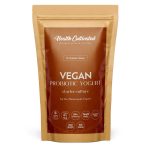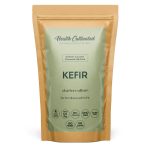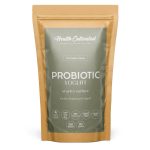Nourish Awards Winner 2025 🏆 | Food & Drink Scotland StartUp Finalist 2025 🏆
What you’ll need:
- 1 Sachet of HealthCultivated starter culture (you can ferment from 1 to 3 liters of milk with 1 sachet)
- Milk (cow, goat, lactose free). You can use UHT, pasteurised homogenised milk, or raw milk. The fattier milk is used, the thicker the final product will be.
- Food Thermometer.
- Yogurt maker or any similar appliance that can hold 38-42° C for 6-12 hours.
Note
Containers for mixture and fermentation should be clean. It is recommended to treat them with boiling water before using.

1. Bring the milk almost to a boil, cool to 38-42°C
We recommend using a food thermometer to control the temperature.
Note
Containers for mixture and fermentation should be clean. It is recommended to treat them with boiling water before using.

2. Add the starter culture to the milk
Mix thoroughly. 1 sachet of starter culture is enough for fermentation up to 3 liters of milk.

3. Pour the mixture of milk and starter
into a yogurt maker or any similar appliance that can hold at steady 38-42° C for 6-12 hours.

4. Turn the appliance on
a. If you have a yogurt maker without a temperature
selection, just turn it on according to the instructions.
b. If you have a yogurt maker with adjustable temperature,
use the «yogurt» or «+40 °C» mode. Fermentation time: 6-12
hours. The fermentation time depends on the temperature
of fermentation and the milk type used. The longer you
incubate, the more tart your yogurt will be. Soy milk requires
more time to ferment

5. After the fermentation time is over, make sure that the product has thickened properly
Well-set yogurt should be thick when whole milk is used. If semi skimmed milk is used it should pull slightly away from the sides of the container when it’s tilted. If it hasn't, continue the fermentation process for an additional 1-2 hours and check it out again.

6. The ready-to-use product should be cooled in the refrigerator for at least 3 hours.
Don’t mix yogurt before it has cooled.
Refrigerating helps set the yogurt. The best taste is achieved during the maturating process in the refrigerator within 3-6 hours, but you can consume the product immediately after it is cooled off.
Occasionally, when yogurt has undergone fermentation at higher temperatures, you might notice the presence of a watery and slightly yellowish liquid on the surface, known as “whey.”
This is normal. You can either remove the whey by pouring it off or mix it back into the yogurt after the yogurt is cooled.

7. Consume the ready-to-use yogurt within a week
You can add fruits, oats, nuts, honey or sugar to your yogurt before eating.
Greek Yogurt Straining
You can eat Greek yogurt right after the refrigeration like a probiotic yogurt.
Or if you prefer a thicker yogurt, you can strain it using cheesecloth or coffee filters inside of a salad spinner or colander, or use a special Greek yogurt strainer pouch.
Straining allows separating yogurt from extra whey. The time required to make Greek yogurt will vary according to your straining method and how thick you prefer your yogurt. The longer you strain, the thicker the yogurt.
After straining keep your Greek Yogurt in the refrigerator and consume within 7 days.
Our Tips For Successful Cultivating:

It's best to use fresh milk for fermentation.
Utilizing slightly older milk to make yogurt is not recommended. Fresher milk not only enhances the taste but also extends the shelf life of the finished yogurt.

Feel free to explore various types of milk with di erent fat contents and experiment with different brands.
Typically, whole milk yields thicker yogurt compared to non-fat milk. Additionally, you might discover that certain milk brands tend to produce yogurt with a richer texture and flavor than others.

While pasteurized and UHT milk have already undergone heating, we strongly advise not to skip the recommended heating process
This step can effectively eliminate any unwanted bacteria that might be present in your milk and ensure a more reliable fermentation outcome.




